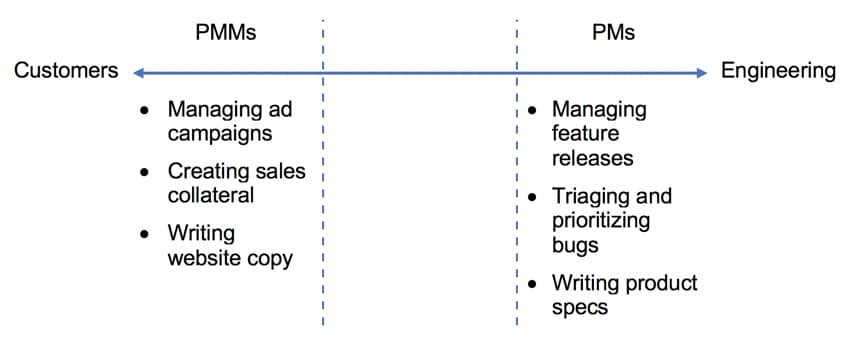In technology and software companies, there are product management (PM) and product marketing management (PMM) roles. People often ask, what is the difference between the two roles? They both focus on a product, so how do they divide the tasks that need to be done?
Responsibilities of PM and PMM
When you think about a PM’s responsibility, the first thing that comes to mind is communicating with engineers to build a product; and for a PMM, it is creating marketing materials for the product. The PMs are facing engineers, whereas the PMMs are facing customers or salesmen. Let’s visualize this below.
It seems obvious that PMMs take the lead on the customers side and PMs take the lead on the engineering side. So, what happens to other tasks like product strategy? The middle part is the place for it.
The middle part is where the responsibilities of the two roles are unclear. It contains tasks, such as defining the market, developing pricing strategies, and performing cost-benefit analysis. There are three key factors that influence the distribution for tasks:
- Strengths and interests of the PM and PMM
- Availability – for example, if a PM is overloaded with managing a feature release, a PMM may take the lead on defining go-to-market strategy
- Work culture/structure – for example, some companies put PMs in the engineering team and PMMs in the marketing team. Ultimately, every firm defines the PM and PMM role differently, and they will do tasks that support the team they are in
Example: Xbox Console Development and Marketing
Let’s consider the Xbox Console launch by Microsoft led by their PM and PMM.
The PM focused on product development, strategy, international go-to-market planning and execution, and collaborated with management, finance, hardware engineering and third-party partner teams.
The PMM defined the product, analyzed industry trends and opportunities, forecasted customer needs, and created the value proposition. The PMM worked with business planning, retail, and events teams to align business priorities and field communication.
After that, the PMM would have also devoted a bulk of their efforts to ensuring that communication with customers about product features was clear and effective, including tasks like organizing an event for the customers. At the same time, the PM likely focused on working with the engineering team to develop the required functions.
Obviously, this example only highlights a tiny portion of the overall work required to launch the Xbox. Yet, it should illustrate the nature of the collaboration between PMs and PMMs, as well as the delineation between the two roles.
Which role should I pursue?
Like any other roles, you have to evaluate your interests and skills in order to decide which role is the best for you.
MinJu Kang is a junior at the University of Waterloo. She is currently working as an Associate Product Marketing Manager (APMM) at Microsoft within the Azure, Cloud + Enterprise team. She also has prior experience at banks focusing on digital channel strategy and at a FinTech start up in a BizOps capacity. She is always open to a nice coffee chat
Image: Pexels



